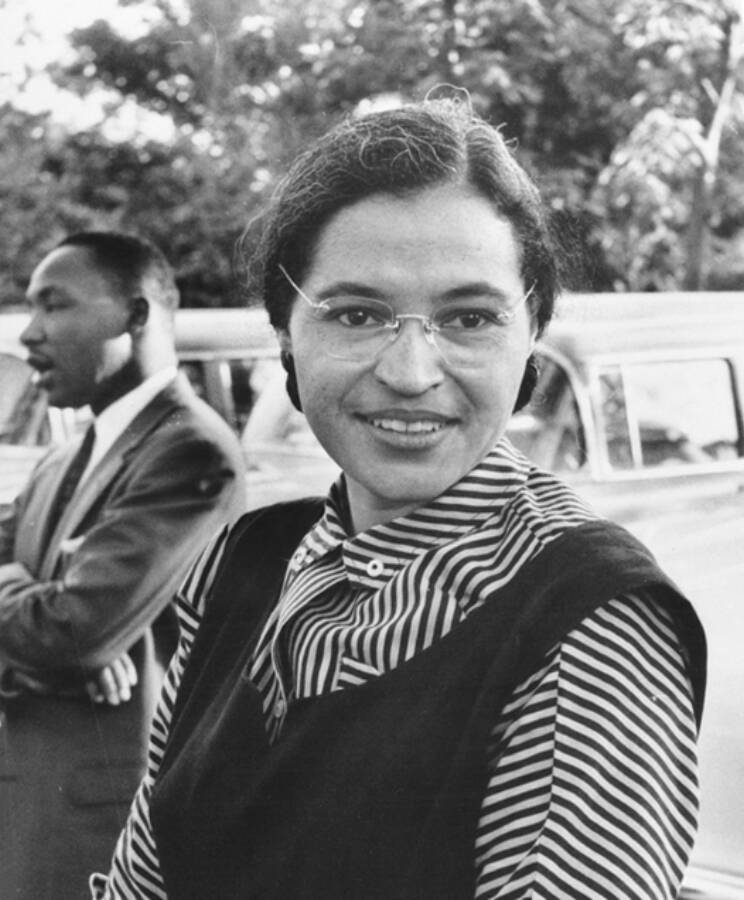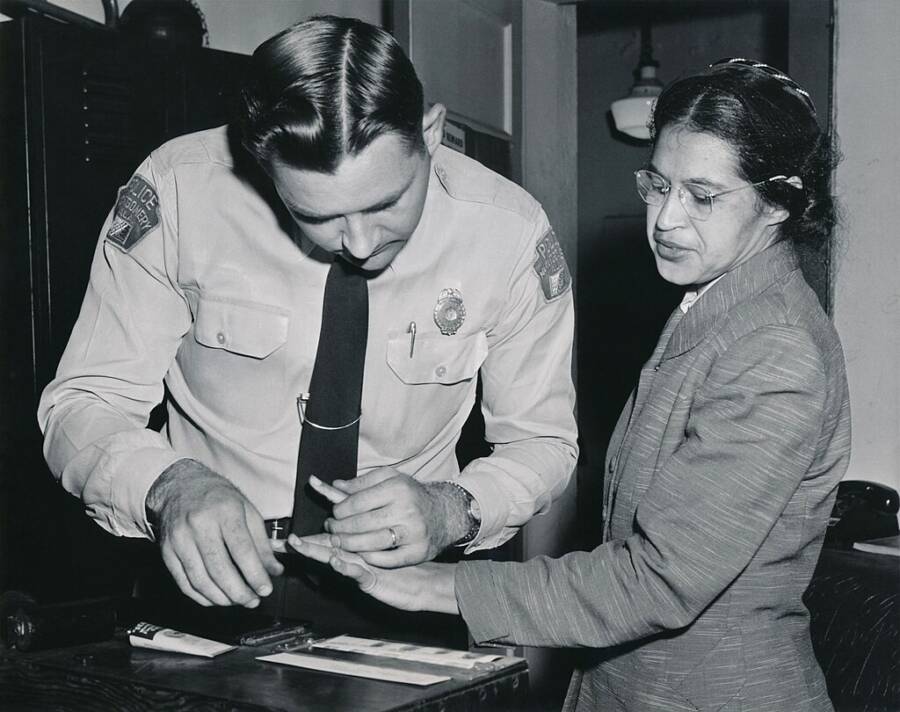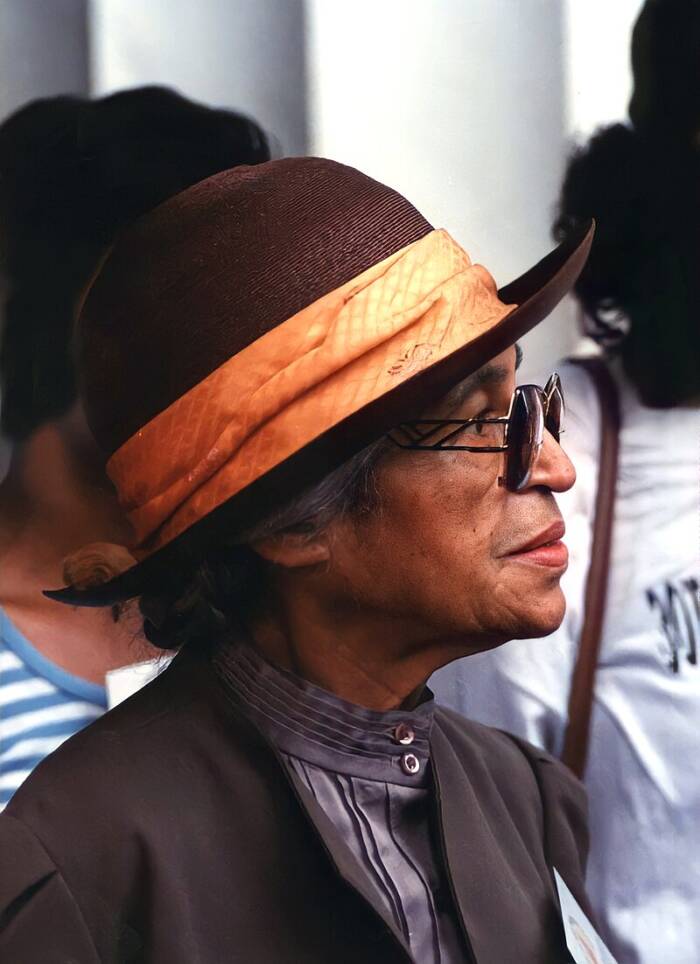Rosa Parks died from natural causes on October 24, 2005, leaving behind a legacy as the "mother of the civil rights movement" who forever changed the lives of Black Americans.

Public DomainRosa Parks, the “mother of the civil rights movement,” circa 1955, with Martin Luther King Jr. in the background.
Rosa Parks’ death on Oct. 24, 2005, came almost exactly 50 years after she made history by refusing to leave her seat for a white man on a city bus in Montgomery, Alabama. This simple act of disobedience was the spark that ignited the civil rights movement in the United States, which ultimately led to the abolishment of segregation laws.
Parks died of natural causes at her home in Detroit, Michigan, at the age of 92. She’d been diagnosed with progressive dementia in 2004, but she hadn’t been in the public spotlight for several years prior to that due to her age and frailty.
The memorials that were held in her honor and the outpouring of grief across the nation highlighted the impact she had made on the country and particularly on the Black Americans whose lives were changed because of Parks and activists like her.
The death of Rosa Parks also came only three years before the people of the United States elected the first Black president, Barack Obama, showing how much things can change in just a single lifetime.
The Early Life And Activism Of Rosa Parks
Rosa Louise McCauley was born on Feb. 4, 1913, in Tuskegee, Alabama. As a young child, she worked on a nearby plantation, picking cotton for 50 cents a day to help support her family.
She dropped out of school as a teenager to take care of her mother and grandmother while also laboring on her family’s farm and as a domestic worker in the homes of white families. At the time, Jim Crow laws were in full effect, enforcing the segregation of white and Black populations in the American South. Her experiences during these years would later guide her work as an activist.
On Dec. 18, 1932, Rosa married Raymond Parks, whom she called “the first real activist I ever met.” He inspired his new wife to participate in activism herself, earn her high school diploma, and accept a job at Maxwell Air Force Base, where she first experienced integration.
In 1943, Parks started attending meetings for the National Association for the Advancement of Colored People (NAACP), and she was elected the secretary of the local chapter that same year. She and her husband were also members of the Voter’s League, where they worked to help register Black voters in Alabama.

Wayne Hsieh/FlickrThe bus that Rosa Parks rode in 1955 is now on display at the Henry Ford Museum in Michigan.
Still, in her daily life, Parks faced the realities of segregation and Jim Crow laws. She grew tired of being humiliated and made to feel as if she were less than human, so when a bus driver asked her to stand up so a white man could sit down on Dec. 1, 1955, she refused.
Her arrest led to the Montgomery bus boycott, which in turn led to the explosion of the civil rights movement as a whole.
Parks later wrote in her autobiography: “People always say that I didn’t give up my seat because I was tired, but that isn’t true. I was not tired physically, or no more tired than I usually was at the end of a working day. I was not old, although some people have an image of me as being old then. I was forty-two. No, the only tired I was, was tired of giving in.”
And until Rosa Parks’ death in 2005, she maintained this refusal to give in, helping to change the lives of millions of Americans.
A Moment Of Defiance Becomes A Lifetime Of Advocacy
The Montgomery bus boycott stretched for an impressive 381 days. Because Black Americans accounted for over half of all the commuters on the city’s buses, the transportation companies felt the effects immediately.
The city fought back against the protesters fiercely, even arresting Martin Luther King Jr. and other activists who championed the cause. On Feb. 22, 1956, Parks and 88 other civil rights leaders were charged with breaking laws that prevented boycotts without “just cause.”

Public DomainRosa Parks gets fingerprinted for her role in the Montgomery bus boycott.
Despite the arrests and fierce pushback, the city ended segregation on its public buses on Dec. 20, 1956, after the U.S. Supreme Court declared the practice unconstitutional.
The boycott launched Parks to fame amongst civil rights activists. However, her newfound celebrity came with downsides, as she and her husband both lost their jobs and faced death threats. In order to avoid the spotlight, they ultimately relocated to Detroit, Michigan, to rebuild their lives. Still, Parks continued her support for the growing civil rights movement.
Throughout the 1960s, Parks participated in several key events, including the 1963 March on Washington, where Martin Luther King Jr. delivered his famous “I Have a Dream” speech, and the marches from Selma to Montgomery in 1965.

Public DomainRosa Parks in 1978, when she was 65 years old.
Later, Parks would involve herself with the teachings of Malcolm X and the Black Liberation Movement. And in the 1980s and ’90s, she was a vocal denouncer of apartheid in South Africa.
Even as she grew older, Parks continued to appear and even speak at events and commemorations to mark the success of the work that she and so many others had risked their lives for.
How Did Rosa Parks Die?
Rosa Parks had struggled with a handful of physical ailments since the 1950s, including insomnia, stomach ulcers, and a heart problem. Her mental faculties began declining in the early 2000s, and in 2004, she was diagnosed with progressive dementia.
Then, on Oct. 24, 2005, Rosa Parks died at 92 years old. She passed away at her home in Detroit from natural causes, surrounded by her loved ones.

John Mathew Smith/Wikimedia CommonsEighty-year-old Rosa Parks in 1993.
Following the announcement of Rosa Parks’ death, officials in Montgomery and Detroit ordered the placement of black ribbons on the front seats of city buses to honor the “mother of the civil rights movement.” Several memorial services were held for her across the country, including one in Montgomery, where Condoleezza Rice spoke and stated, “I can honestly say that without Mrs. Parks, I probably would not be standing here today as Secretary of State,” as reported by NBC News at the time.
When Rosa Parks’ remains were being flown from Montgomery to her service in Washington, D.C., the pilot circled the Alabama capital twice while singing “We Shall Overcome,” the anthem of the civil rights movement.
In D.C., Parks became the first woman to lie in honor at the Capitol Rotunda, and some 50,000 people came to view her casket, including President George W. Bush. Finally, her funeral in Detroit was held on Nov. 2, 2005 and attended by over 4,000 people. There were 2,000 seats available for the general public, and the line to get in stretched for blocks.

AOC Photo / Alamy Stock PhotoRosa Parks lying in honor at the U.S. Capitol Rotunda on Oct. 30, 2005.
Aretha Franklin performed at the service, which lasted for seven hours. Future U.S. President Barack Obama, who was still a senator in Illinois at the time, also spoke, saying, “And yet when the history of this country is written, it is this small, quiet woman whose name will be remembered long after the names of senators and presidents have been forgotten.”
Parks was interred at Woodlawn Cemetery beside her husband, who had died in 1977.
While Rosa Parks’ death marked the loss of perhaps the most famous civil rights activist after Martin Luther King Jr., her contributions and goals are still celebrated two decades later. During a speech in 1988, Rosa Parks reflected on the legacy she wished to leave behind after her death, stating:
“I am leaving this legacy to all of you… to bring peace, justice, equality, love and a fulfillment of what our lives should be. Without vision, the people will perish, and without courage and inspiration, dreams will die — the dream of freedom and peace.”
After reading about Rosa Parks’ death, go inside the tragic story of Martin Luther King Jr.’s assassination. Then, learn about the assassination of Malcolm X and the hunt for his true killer.





